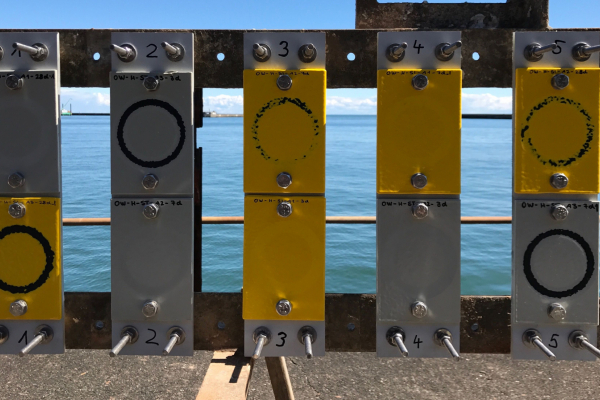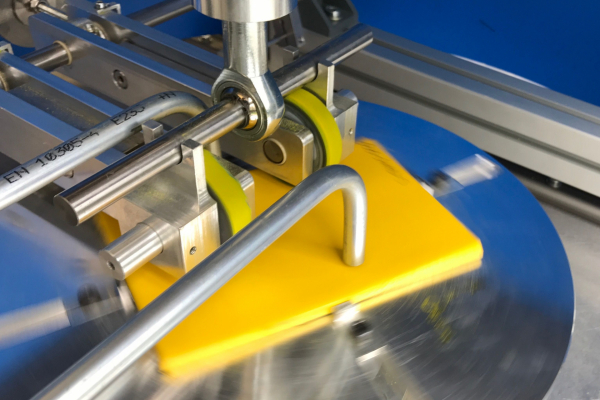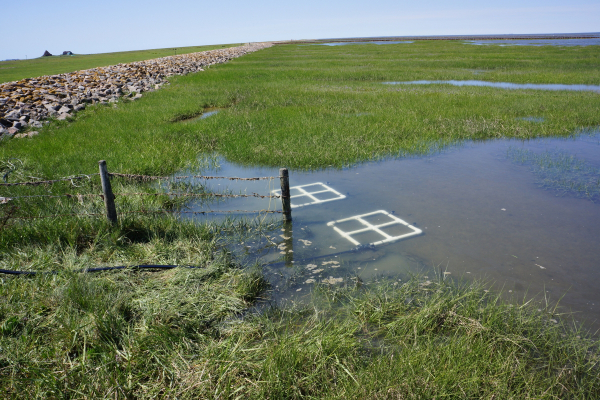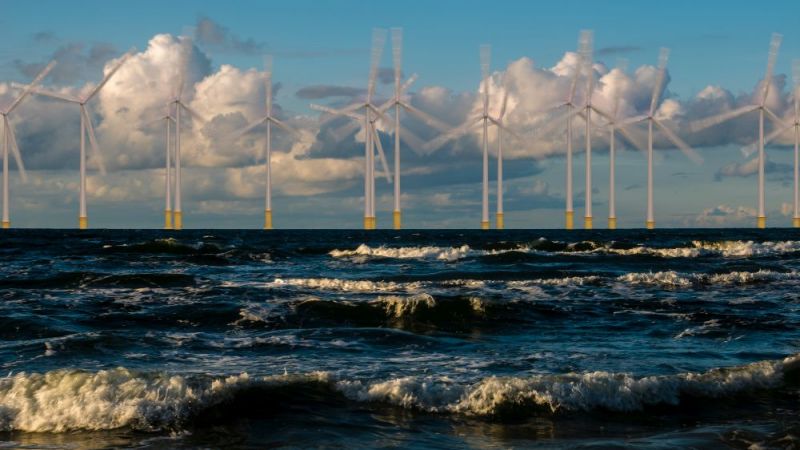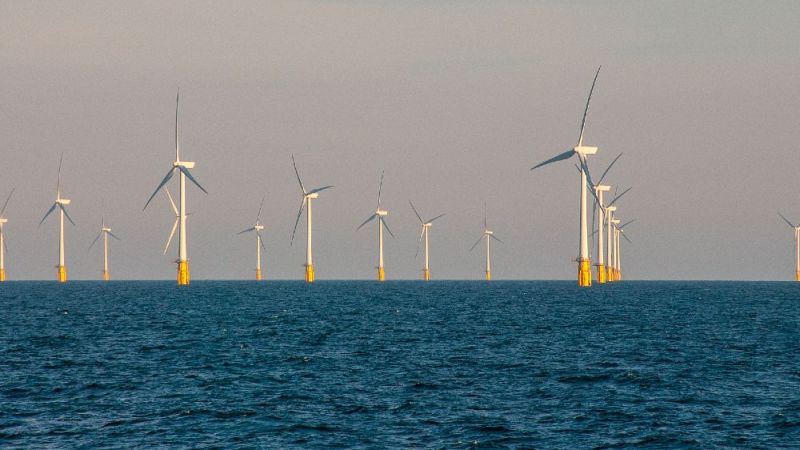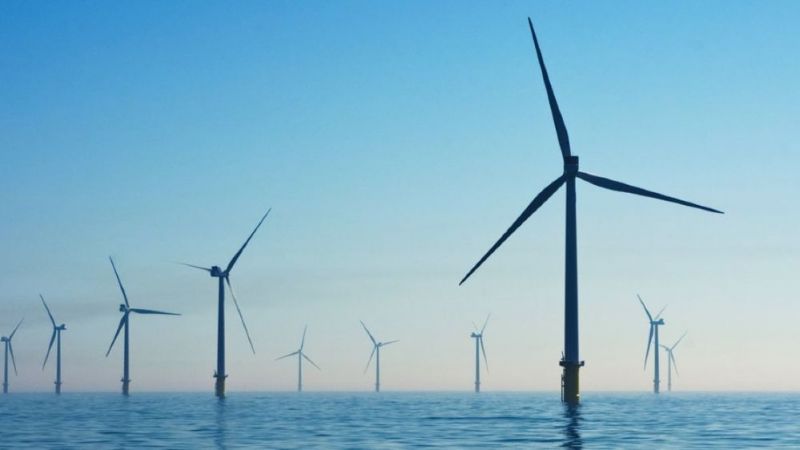Wind power
Protecting wind turbines from corrosion
Offshore wind turbines are exposed to harsh environmental conditions throughout their operating time. The corrosion protection used must therefore function optimally over the planned operating time of 25 or more years. Steel corrodes when it comes into contact with oxygen and water and rust forms. This weakens the component and its durability. Scientists investigated how, for example, mechanical stresses, marine fouling and microorganisms affect the corrosion or corrosion protection of the support structures. The results are currently already being taken into account in standards and test procedures.
Corrosion protection reduces operating costs
Suitable corrosion protection reduces operating costs, especially for offshore wind turbines. Costly maintenance work that requires the use of ships or helicopters and usually also leads to unprofitable shutdown periods of the plants can be reduced.
Within the OptiWind project, short for "Development of holistic, environmentally sound corrosion protection to minimise overall costs through optimised and coordinated production sections for offshore wind turbines", the project partners focused on the support structures of wind turbines. They were interested in the influences to which the components are exposed and how these affect the corrosion protection. This also includes risks from marine fouling and microbially induced corrosion.
Material layers protect support structures of offshore plants
These are usually both passive, multi-layered coatings of epoxy resin and polyurethane designed to prevent the steel structures from coming into contact with saltwater, and active systems using aluminium anodes or protective current. These active systems, also known as cathodic corrosion protection, use protective potentials on the surface of the components to create a stable state in which ongoing iron dissolution is prevented. This is an electrochemical method. A direct current flows onto the areas to be protected and prevents metal ions from being dissolved from the surface.
In the OptiWind project, the scientists investigated how coating systems based on an epoxy and a polyurethane system behave at different protective voltages. The epoxy system proved to be the more resistant system in this case. The reason for this are small pores within the material layers. This allows hydrogen to escape, which is produced at the interface of the coating to the steel. The coating is more durable.
In further tests, the project teams examined the most common mechanical stresses, such as compression and impact loads, as well as the abrasion behaviour of coatings. The results showed that the investigated coating materials react much more sensitively to impact stress than to compression forces. The degree of dryness reached by the coating plays a decisive role here. The faster a coating sets, the sooner it can absorb forces acting on the component.
Minor damage is collected and conserved on site
The temporary corrosion protection systems preserve the surface temporarily until the next repair campaign. At the same time, they acts as markers and help to quickly locate the areas that require repair. The application and performance capability of such temporary systems, which are mostly based on very simple methods and solutions, have not yet been investigated to a sufficient extent and under the aspect of corrosion protection. After a few months, or in favourable weather, the damaged areas preserved in this way can be professionally repaired.
First, the researchers conducted experiments with different material samples that are suitable for temporary repairs. To do this, they constructed special steel test sample bodies with screws, welded-on steel angles and defined damage. They exposed the samples to an offshore-like marine situation. After a short time, the first corrosion damage appeared, which they covered with various temporary repair kits, such as adhesive tapes made of polyurea, aluminium or rubber. They first had to remove the old coating from the areas to be worked on and prepare the surface specifically and quickly for the provisional measure. One of the methods the project partners successfully tested and used for this step was a laser-based system.
Microorganisms influence corrosion on foundation structures
A variety of microbial processes occur in marine sediments that accelerate the corrosion of unprotected steel structures in the sea. Within the OptiWind project, the scientists investigated the microbially influenced corrosion processes and focused on sulphate-reducing and sulphur-oxidising bacteria. These play a key role in microbially influenced corrosion. Certain types of sulphate-reducing bacteria in particular can use iron electrons from unprotected steel for their metabolism. They also form strong acids, such as sulphuric acid, which can also drive the corrosion process. This often results in so-called "pits", which are small holes or craters in the steel surface. These are locally limited, but very quickly cause material loss deeper down and can thus cause component failure.
The bacteria mentioned are found in large numbers in marine and brackish water sites. Their colonisation density depends on the prevailing environmental conditions, such as the composition of the sediment and the available nutrients. To determine the exact density in the North and Baltic Seas, the researchers took sediment samples at selected locations, each in summer and winter, and analysed the microbial community. They were able to detect sulphate-reducing and sulphur-oxidising bacteria at every sampled location. However, their numbers vary seasonally both from location to location and within the locations. This means that the time of investigation is crucial when it comes to analysing the substratum. Risks could otherwise possibly be underestimated.
Concept for substratum analysis takes local influences into account
The microbial community changes in the immediate presence of steel components. Field tests showed how great the influence of the microorganisms at the offshore plant actually is, with the proportion of sulphate-reducing bacteria in particular increasing. If steel plates are not protected by an external current system (-900 millivolts), the steel will corrode more. Overall, the analyses showed a very heterogeneous picture of the microbial community. Based on the comparative analyses carried out, there is no single substratum condition that can be targeted for action. In principle, microbial communities that pose a potential risk exist at many locations. Whether this is really relevant is determined by various locally varying environmental parameters. Nevertheless, on the basis of the research work, the scientists were able to develop concepts for substratum analyses that take local influences into account. These can provide important recommendations for designers, installers and operators in order to prevent corrosion. This requires consideration of the plant design and the intended corrosion protection concept.
The planning phase determines the expected operating costs
The researchers therefore developed two models to determine the expected operating costs. They are based on a jacket structure and a monopile as the support structure. Costs for manufacturing, construction, operation and dismantling of the plants are taken into account. The aim is to determine the economic added value of a technical measure compared to other possible measures. For example, whether anchor points are advantageous for faster repairs and allow industrial climbers to reach damaged areas more quickly and safely. Costs for technical measures can also be compared with the costs incurred as a result of additional inspection requirements. The models are modular and can be adapted to new requirements. Already during the planning phase, the operating costs can be considered in terms of economic and ecological aspects dependent on the products chosen, for example for the coating.
Research results are reflected in guidelines and standards
The knowledge gained has already been incorporated through committee work in "DIN 18088-1:2019-01 1 - Part 1: Support structures for wind turbines and platforms and the standard paper "Corrosion protection of offshore wind turbines and wind farm components" by VGB PowerTech (VGB) and the German Federal Waterways Engineering and Research Institute (BAW). The same applies to the results on the handling of coatings, which have been incorporated into the guideline "Corrosion protection of offshore wind turbines" of the Gesellschaft für Korrosionsschutz e. V. (GfKORR).
Last updated: 17.06.2021


